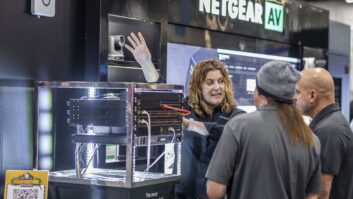Everyone has been saying it for years, and I’m sure all of you are seeing it in your business: networking is now core to our business and all of us need to have strong networking skills within our business, if not within our own heads.
This week we went to troubleshoot for a new client and when we got into the home, it was apparent pretty quickly that the network was the culprit. Their audio was dropping out, they were losing connection from their iOS devices to their AV equipment, and their Netflix was taking forever to load. Heck, even while talking to them on the phone I was 90 percent certain it was the network.
It turned out they were relying on their ISP’s old router/WAP, which was at least five years old, only had 2.4 GHz bandwidth, and was providing maybe 10mbps speeds. Their prior integrator had put the system in just two years ago but didn’t do any networking work; after some gentle questioning, I found out they never even discussed or offered networking work (likely because they didn’t feel comfortable doing it).
This got me to thinking. What are the basics an integrator should know in order to feel comfortable enough to provide a client with a rock solid network? Here are my five takeaways:
1.Use enterprise grade gear. It is very tempting to just pop in a couple of Airport Extremes set in bridge mode to act as WAPs and call it a day. While it will improve wireless coverage, it will not make the backbone of the network more robust. Bypassing the ISP router and putting in an enterprise grade router and WAPs will make the network much more robust and grant you greater control over it, including the ability to remotely access the network and troubleshoot issues remotely without having to roll a truck. So spend a little money and put a router and a WAP or two in your showroom or own home, maybe even a managed switch too. Step out of your comfort zone and force yourself to learn it. Once you’ve installed it and have to get it working, you’ll pick it up quickly. That’s why I recommend putting it in your own home first: there’s no better motivator for getting the network up and running than an upset spouse and kids who can’t get on Facebook or binge watch Spongebob. In fact, I knew that my friend Mark Feinberg of Home Theater Advisors was a little intimidated by networking; he was hemming and hawing about learning and upgrading to Pakedge gear from his FiOS Actiontec router and two Airport Extremes set up as WAPs. So I gave him a Crestron PYNG hub to force him to upgrade. Since PYNG and FiOS Actiontec don’t play well together, if he wanted Crestron Automation, he was going to have to learn!
2.Know the ISPs in your area. As mentioned above, you’ll need to bypass your ISPs router. That may be as easy as logging into the existing router and putting it into bridge mode (Time Warner Cable in the NYC area), or if your client has Verizon FiOS, calling FiOS to activate the Ethernet jack on the ONT, and then rewiring the system to keep their router in the mix to serve the STBs their on-screen data, but to not manage network traffic. This is tough to directly experience on your own, as I don’t expect many of you have multiple ISPs you subscribe to at home. This is where Google is your friend. Look up the standard admin username and passwords for the ISP routers in your area (TWC is the standard admin/password, and FiOS now prints it on a label on the Actiontec routers). Read through it and know what you have to do. A great resource for those of you who have to work with FiOS is available from dslreports.com.
3.Know what Static IPs and DHCP Pools are and standardize your Static IP addresses. From here I will assume you know and are comfortable with Static IP addresses. If you aren’t, Google “how to set a static IP address” and read away! Luxul also has some great training on its website, free to all. Or check with your favorite distributor to see if they offer networking trainings or if their preferred networking equipment manufacturer offers in-person or webinar-based trainings. On to my point: when setting static IP addresses, choose a standard to use throughout your business that will help you troubleshoot issues and make it easy for your techs when they get onsite. At The Source Home Theater, all of our networking gear gets addresses in the xxx.xxx.xxx.2-20 range. That includes switches, WAPs, computers, printers, etc. All AV processors are in the .21-.30 range and all hardwired AV components are .31-.60.
4.Use both 2.4 GHz and 5 GHz bands. I know this may sound basic to a lot of people, but I also know there are a lot of people out there who still don’t activate the 5 GHz bands in their client’s routers (I’ve noticed, especially when using Apple Airport Extremes, since the Airports don’t activate it by default). While both bands have their advantages and disadvantages, it is almost always better to have both active and to tell customers to connect to the 5 GHz band when within range, and to use the 2.4 GHz otherwise. For those who are not aware, the 5 GHz band has faster speeds, can carry more bandwidth, and has much less interference. However, the 2.4 GHz band has longer range and can penetrate walls and other surfaces better.
5.Sign up for a Dynamic DNS service. A DDNS, as it is called, allows you to always reach your client’s home from the outside, even if the IP address assigned to them by their ISP changes. This is similar to how a website works: you don’t type in the IP address of a website, you type in the URL and it always goes to the IP address. Now, most commercial websites have static IP addresses, but most of our clients’ homes have DHCP-assigned addresses, and therefore we need a way to access it reliably both for remote access and for them to control their homes remotely. You may even be able to get a DDNS service for free from one of your manufacturing partners. Crestron offers a free service through mycrestron.com and the new Pakedge RE2 routers come with a free DDNS service as well.
There you have it, my top five list of must-knows for basic networking competence. What would you add to the list? Help out your fellow integrators by sharing your top tips below in the comments.
By the way, we upgraded the client in the opening paragraph to a Pakedge RE2 router and W7 WAPs. Their system is rock solid and all performance issues have been solved.
+Todd Anthony Pumais president of The Source Home Theater Installation, in New York City.







